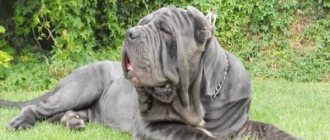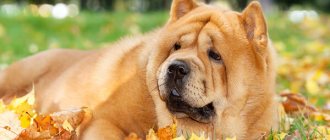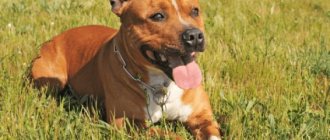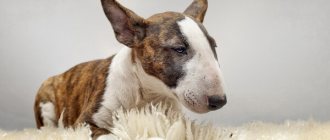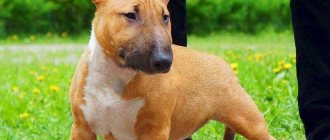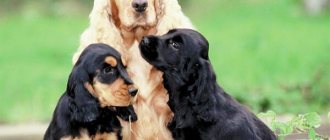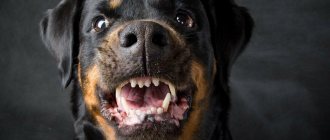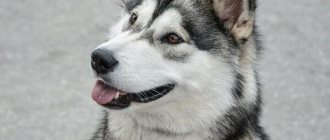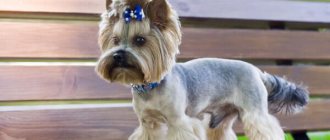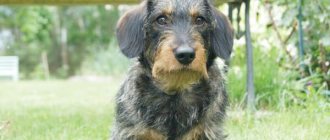- Pets
- >>
- Dog breeds
* Here is a photo of a typical representative of the Staffordshire Bull Terrier dog breed . You can send us photos of your animals by email, and we will post them on the website. Don't forget to send your pet's name.
Other breed names:
English Staffordshire Bull Terrier
Description and breed standard
The English Staffordshire Bull Terrier is a medium-sized, strong, stocky, well-balanced dog with well-developed muscles.
NOTE!
Representatives of this breed, despite their rather modest size, embody enormous physical strength and power, which, combined with low sensitivity to pain, makes them ideal fighting and hardy dogs.
Breed standard
:
- deep, wide, shortened head;
- short muzzle;
- wide jaws;
- scissor bite;
- the nose is large, the earlobe is black;
- eyes are medium in size, set wide, low, horizontally, the iris is dark or matches the color of the coat;
- ears are semi-erect or pink-shaped, not cropped;
- the body is muscular, heavy, but fit;
- the back is straight, the chest is deep, the neck is strong and wide;
- the tail is thick at the base, tapers towards the end, has medium length, and is set low;
- The paws are straight, set parallel and wide, the pads are round and small.
The coat of the Staff Bull Terrier is short, thick, close to the body, and the undercoat is short.
History of appearance
The ancestors of bull terriers were mastiff-like dogs, spread by the Romans throughout Europe. These animals were used as gladiators in the arenas in fights with bulls, lions and bears.
Mastiffs, despite their strength and power, were not suitable for fights because they were too clumsy and cumbersome, so in the county of Staffordshire, by crossing English bulldogs and Molossians, a new breed of dog was developed, the representatives of which were compact in size, speed and agility.
Over time, gladiator fights lost popularity and became prohibited, so breeding work was aimed at changing the temperament of these dogs and adapting them to life in the city. The breed received official recognition in 1939.
However, back in the 19th century. Staffordshire bull terriers and European dogs with similar features were exported to America, where there was no ban on dog fighting.
Breeders from the USA developed a new breed - pit bull terriers, which were distinguished not only by greater strength and endurance, but also by a higher level of aggression. These dogs were recognized in 1898 and given the name "American Staffordshire Terriers."
IMPORTANT!
Work to improve Amstaffs has led to their character becoming softer and more good-natured, which is a fundamental difference from pit bulls and staff bulls. This was the reason for the division of these dogs into separate breeds in 1936. Amstaffs were recognized by the FCI in 1972, English Staffordshire Terriers - in 1974.
Video
* We invite you to watch a video about the Staffordshire Bull Terrier . In fact, in front of you is a playlist in which you can select and watch any of 20 videos about a given dog breed by simply clicking on the button in the upper right corner of the window. In addition, the material contains quite a lot of photos. By looking at them you can find out what a Staffordshire Bull Terrier looks like.
In this article:
|
Character traits
English Staffordshire Bull Terriers have a difficult character.
They are brave, fearless, cheerful dogs, devoted to their owner and his family.
Representatives of this breed are smart and quick-witted and are easy to train. You need to start training your pet as early as possible, and you need to show him who is in charge and define the boundaries of what is permitted literally from the first days the puppy appears in the house.
Staffbulls always strive for victory and leadership, so it is necessary to make them understand that the “pack leader” is the owner, otherwise it will be impossible to achieve obedience.
Being energetic, strong and hardy animals, these dogs need regular exercise and active walks.
It is good if walking representatives of this breed includes not only walking or running, but also elements of training, as well as sports - agility, frisbee, weight-pulling. This helps not only release your pet’s energy, but also maintain its physical and mental health.
Staffbulls get along well with other pets, but only if they were raised together. The good attitude of these dogs does not apply to animals on the street or living in the neighborhood.
Their relationships with dogs, especially same-sex dogs, develop negatively. This is due to the desire of representatives of this breed for unconditional leadership and the spirit of battle that remains in them.
Expert opinion
Kozhevin Semyon Kirillovich
Expert dog handler.
English Staffordshire Bull Terriers are not a breed for everyone and certainly not for beginners. These dogs need owners who not only have experience in keeping and training dogs, but also self-confidence and the ability to be a leader. The authority of the owner must be undeniable - the staff bull must respect him and feel his superiority, only in this way will he obey and not become a threat to people.
History of the Staffordshire Bull Terrier breed
Staffordshire Bull Terrier
The Staffordshire Bull Terrier is a breed whose birth was dictated not by practical necessity, but by a thirst for profit. At the beginning of the 19th century, a new type of entertainment came into fashion among the English poor - dog fighting. Every weekend, crowds of onlookers flocked to some spot, where they watched with delight as animal owners pitted their charges against each other. Here bets were placed on victory, which only further fueled interest in the wild, but such an exciting “sport.”
At first, mostly bulldogs performed in the ring, which were later joined by representatives of the terrier group. However, the animals had difficulty holding the audience's attention. The people, fed up with standard bullying, longed for a cruel show, and what they got was another dog showdown with techniques that had been studied inside and out. In order not to lose the viewer, and with it a stable income, the owners of the four-legged fighters had to dodge and experiment with the genetic base. This is how a hitherto unknown variety of dogs called bull and terriers began to appear on the sites.
Representatives of the new breed, born by crossing a bulldog with an English terrier, surpassed their ancestors in the art of fighting, and indeed in everything related to resourcefulness, excitement and reaction speed. In addition to outstanding fighting qualities, the animals also showed mouse-catching talent, so demonstrative rat baiting with the participation of a bull and terrier quickly turned into a favorite spectacle of the English lower classes. A dog named Billy was especially successful in this matter; in 1823 he set his sights on the world record. In just over five minutes, the dog strangled 100 rats, which in turn also wasted no time and furiously attacked the enemy.
Further breeding of bull and terriers proceeded spontaneously. No one limited breeders in “creative experiments”, so soon three intra-breed types of Staffies were formed in England:
- Cradles are compact, strong animals with well-developed bones;
- Warlaston – medium-sized, moderately well-fed dogs with short bulldog legs;
- Varsol is the type closest to terriers with long limbs and a dry constitution.
Staffordshire bull terriers acquired their modern appearance only in the second half of the 19th century, and they managed to acquire a breed standard only in 1935, after dog fighting was outlawed in Great Britain. By the way, the same Cradley type was declared the standard of appearance for the breed, endowing its representatives with a stocky constitution and characteristic bonyness.
Differences from the American Staffordshire Terrier
Despite common roots, representatives of these breeds have significant differences:
- Staffbulls were bred in England, and Amstaffs were bred in the USA;
- Staffordshire Terriers are much larger and heavier;
- "American" ears can be cropped;
- Staff Bulls can get along with other pets that grew up with them; Amstaffs are too jealous and intolerant.
In addition, according to statistics, the difference in life expectancy between Staffbulls and Staff Terriers is 1-2 years in favor of the latter.
Advantages and disadvantages
The main advantage of Staffbulls, which everyone who sees these dogs first of all pays attention to, is their power and strength, which are combined with compact size and a certain aristocracy of the breed.
In addition, these dogs have the following advantages:
- friendly character;
- devotion;
- love for children;
- balanced psyche;
- high pain threshold;
- courage;
- high level of intelligence;
- ability to learn;
- absence of unmotivated aggression towards people.
Negative traits of this breed:
- the desire for leadership and the desire to show that they are stronger;
- poor relationships with other animals;
- stubbornness;
- year-round molting;
- intolerance of loneliness;
- the need for early socialization and competent education;
- need for regular active walks.
NOTE!
It should also be understood that Staffords, due to their compact size, are not suitable for use as home guards.
Advantages
All Bullies adapt to their owner. If they are inadequate, then it is the person’s fault. For the most part, dogs are easygoing with people, friendly, love children and even become nannies for them.
- Dogs are very devoted to the family and can serve as protectors. Although, due to their size, Staffbulls are not very suitable for guarding objects.
- They have a balanced nervous system and a high pain threshold.
- Fighting dogs are difficult to anger, although it is still a bad idea to mock them.
- They are very strong, fast and brave, so they can protect themselves and those around them. They are wary of strangers, but not aggressive.
- They are smart, easy to train, and show good results in agility.
Flaws
- All Bulies do not interact well with animals. If these are dogs, they strive to show leadership, to show strength, dominance.
- If cats and small rodents live in the house, dogs consider them prey that needs to be caught and eaten.
- They are quite stubborn and can strive to dominate the family. With proper quality upbringing, this rarely happens.
- Training and heavy physical activity are required - also a minus, because they take up a lot of free time.
- Bulls do not tolerate separation from their owner well and are not suitable for people who are constantly busy or working. It is vital for animals to spend all the time next to their person.
Photos with examples of colors
The coat of representatives of this breed can be of the following color:
- red;
- red and white;
- fawn;
- white;
- black;
- black and white;
- blue.
In addition, a combination of any of these shades with white, as well as brindle and brindle-white colors, is acceptable.
Black and tan or liver colors are considered undesirable.
Nutritional Features
Although Staffbulls are relatively small dogs, their food must be voluminous, high-quality and capable of replenishing large energy costs.
The diet can be based on both natural products and industrial feed; it is only important to ensure that the diet is balanced and contains everything necessary for the healthy growth and development of the dog.
With natural feeding, the pet’s menu should include:
- lean meat (beef, veal, poultry, horse meat);
- sea fish;
- eggs;
- fermented milk products (cottage cheese, kefir, fermented baked milk, natural yogurt);
- vegetables (carrots, red beets, pumpkin, cabbage);
- cereals (buckwheat, oatmeal, rice);
- greenery;
- fruits (except grapes, melons, citrus fruits);
- offal (liver, lung, heart, tripe).
Also, representatives of this breed should be given cartilage, hooves, ears and tails - their use helps strengthen the pet’s teeth and bones.
It is forbidden to feed staff bulls:
- fatty meat;
- tubular bones;
- milk;
- potatoes;
- fried, spicy foods;
- sweets, pickles, smoked meats;
- bakery, pasta and sausage products;
- onions and garlic;
- legumes
IMPORTANT!
It is necessary to monitor the quality of food, the volume of portions and follow the feeding regime, since these dogs are prone to obesity, which leads to unnecessary stress on the joints and heart.
The advantage of industrial feeds is their ease of use and balanced composition, enriched with essential vitamins and minerals.
Economy class food is not suitable for Staffy Bulls. The most suitable diets for representatives of this breed are produced by brands such as Bozita, Solid, Orijen, Genesis, Applaws, Acana, GO!, Grandorf.
Life expectancy and diseases
Despite their fairly good health and strong immunity, English Staffordshire Bull Terriers are insured against diseases.
The most common diseases among representatives of this breed include:
- cataract;
- heart diseases;
- hypothyroidism;
- deafness;
- urolithiasis disease;
- allergic reactions;
- luxation of the patella;
- bloating;
- dysplasia of the hip and elbow joints;
- entropion of the eyelid;
- hyperadrenocorticism;
- mast cell cancer;
- arthritis;
- brachycephaly;
- epilepsy.
The lifespan of staff bulls depends on many factors, including heredity and living conditions. On average, these dogs live 12-14 years.
Health and Diseases of Staffordshire Bull Terriers
Staffordshire Bull Terriers are considered one of the most mentally stable and physically strong breeds. As for genetically determined ailments, Staffies are most susceptible to urolithiasis, volvulus, entropion, hip dysplasia, hyperadrenocorticism, cataracts and cancer. Most well-known nurseries examine their litters for joint dysplasia and patella, which helps to identify and exclude sick individuals from further breeding. Genetic tests for HC (hereditary cataract) and L2HGA (L2-hydroxyglutaric aciduria or genetic epilepsy) are also desirable, since no effective treatment has yet been found for them.
Suitable for living in an apartment or outdoors?
Due to their compact size, dogs of this breed feel equally comfortable living in city apartments and private country houses. But at the same time, they need daily active walks lasting at least 2 hours.
Staffbulls are not suitable for outdoor living because their short coat does not protect them from the scorching sun and cold. In summer, they should be walked early in the morning or after sunset, and for walks in winter, the pet will need warm clothes.
Features of character and behavior
This breed received the status of “especially dangerous” due to its fighting past and improper upbringing.
In many countries, to have such a pet, you need to obtain permission from the city and from neighbors.
This is unfounded. Bulls are friendly towards people, they do not experience aggression or anger, on the contrary, they value their owner and are aimed at interacting with him.
The main difference between Staffbulls and Amstaffs is their gentleness of character. The first ones are not designed to kill the enemy. Yes, they love to fight, but this is only to show strength and leadership. Staffs can actually be aimed at eliminating the enemy.
One way or another, dogs of this breed are serious, they need training, training and education. They will become true friends if behavior is correctly corrected in early childhood.
How are children treated?
Staffbulls get along well with children. These dogs are not inclined to show aggression towards people, and with children they behave calmly and treat them very kindly, becoming excellent nannies and friends.
However, children under 10 years old should not be left alone with a dog. At this age, kids still cannot control themselves and their unceremonious behavior can provoke an unwanted reaction from the staff bull.
Rules of care
These are short-haired dogs, so caring for them does not require much time and effort.
Wool and bathing
The Staff should be brushed weekly using a brush with natural bristles or a special rubber glove. Combing improves blood circulation, helps get rid of dead hairs and stimulates the growth of new ones.
Staffbulls need to be bathed once a month using shampoo for short-haired dogs. You need to wet the fur well with warm water, apply and foam the shampoo, and then rinse thoroughly, making sure that water and foam do not get into your pet’s ears.
The shampoo must first be diluted with water in a 1:1 ratio.
After washing, the dog must be thoroughly dried and combed.
Ears
The ears should be inspected weekly and accumulated wax and dust removed from them with a cotton pad soaked in warm water or a special lotion.
Teeth
To prevent the appearance of plaque and tartar, your dog’s teeth should be brushed 3-4 times a week using a special toothpaste and brush for dogs. You can also give your staffbull special treats that promote mechanical cleaning of the teeth.
Claws
In summer, claws usually wear down on the asphalt while walking. If this does not happen, and also in winter, they should be trimmed with a guillotine nail clipper every 2 weeks. Sharp ends should be smoothed with a nail file to avoid cracking.
To make the claws more pliable and easier to trim, the staffbull's paws should be soaked in warm water for several minutes beforehand.
Eyes
Every morning you need to remove the discharge that accumulates in the corners of the eyes with a clean, lint-free cloth soaked in boiled water or chamomile infusion.
Training and education
| Team | Education |
| To me | After the puppy remembers its name, you need to call it, saying “Come to me!” It is better to do this when the pet is at a distance, but at the same time in the owner’s field of view |
| Near | In order for the dog to learn to walk near the owner’s left leg, without overtaking him or going to the side, you need to say the command and pull the leash, holding the staff bull |
| Sit/lie down | You need to show the puppy a treat, forcing him to raise his head and sit down, and lightly press on his croup. Teaching the “down” command is done in a similar way. |
| Place | Place the puppy in its place, say the command and begin to gradually move away, making sure that the pet does not follow |
Key points in training
Training is important for this breed. Dogs need to be trained from puppyhood. Bullies do not experience aggression towards humans, but they are very strong, so you need to teach your pet to use their physical abilities wisely.
Overall, these dogs are easy to train. They focus on the owner, serve him, and do not try to dominate, although a strong hand would not hurt. This does not mean that the animal should be beaten. Staffbulls will not tolerate such an attitude; to punish them, all they need is a stern look, lack of treats, or temporary isolation in an enclosure or cage. In the most critical situations, pets are pressed to the ground until they calm down.
A distinctive feature of the English Bull Terrier from the American Bull Terrier is that it is completely unsuitable for fighting. Staffbulls are kinder and smaller, they are capable of driving large game or guarding a house, but they never cause harm. Although they don't like other dogs either.
The pet must learn several important rules:
- Feeding is done only after the whole family has eaten;
- You can only enter the house after the owners;
- You can’t sleep, play, or play around on the owner’s furniture.
These simple habits will show the primacy of a person in the home.
Once the puppy remembers its name, you can begin learning commands. You can train your dog on your own or with a dog handler in a club. Boules need to know basic verbal and auditory cues and follow them flawlessly:
- "Near";
- "Place";
- "It is forbidden";
- "Sit";
- "Voice".
An important point in education is socialization. The puppy is accustomed to noisy places, strangers and animals, and public transport. An unsocialized pet may become angry or timid.
Read about how to properly train a dog in the article: “Training a puppy: effective methods from dog handlers, learning commands at home.”
How to choose a puppy?
You should not buy a puppy from someone else or from an advertisement. Only in a kennel can breeders guarantee the purity, health and balance of a dog.
NOTE!
It is best to buy a puppy when he is 2-3 months old - at this age the puppy will most easily cope with moving to a new home, and the new owner will independently develop his habits and character.
If a Staff Bull is purchased as a pet, you can opt for a pet-class puppy; to participate in breeding, you need a representative of the breeding class; if you have plans for a show career, you should purchase a show-class puppy.
Whatever class the future pet belongs to, it must be curious, active, playful, have no symptoms of pathologies (rash, scratching, dandruff, bloated belly, exhaustion, overweight) and developmental abnormalities, and meet the breed standard.
Mating
The breed is not large, mating for the Staffbull is standard. They don't require a lot of space or special recommendations, but it is worth inviting a knowledgeable person, especially during the first denouement. It will help not only pets, but also owners.
Bullies become sexually mature at 10 months. But it is recommended to breed only from 20-25 months, when both the male and female are able to conceive and bear strong offspring. Days 13-15 from the start of the third heat are considered favorable. At this time, the loop loosens, the discharge becomes lighter, and the female becomes playful or aggressive.
If the dogs are pedigree, have status and have pedigree documents, then they need to be bred through a kennel. Namely, get a certificate and fill out the form. The owners agree in advance on the date and price, which is set by the owner of the male. Usually it is equal to one puppy or a percentage of its cost (depending on the number of heads in the litter).
Animals need to be walked together and introduced to them. This takes 15-20 minutes . Then the girl is brought to the territory of the male dog. This is necessary for the male to feel confident. It is believed that if a boy gets used to “home” matings, he will not look for a “bride” on the side.
Read a detailed article on the topic: “Everything you need to know about breeding dogs: appropriate age, what to do if it doesn’t work out, rules and tips.”
If the female is satisfied with everything, she will allow the cage to be mounted. Sexual intercourse does not last long – 10-15 minutes. At this time, the girl should be held by the head and under the stomach, and the boy should be guided into the noose. After several active shocks, a lock should occur. If it didn’t happen, it doesn’t mean that the bitch is empty. Repeated mating is carried out after 2 days.
Price range
On average, Staffordshire Bull Terrier puppies cost 15-40 thousand rubles:
- a puppy without a pedigree can be bought for 15 thousand rubles;
- representative of the pet class - for 20-25 thousand rubles;
- a breed-class puppy will cost about 30 thousand rubles;
- for an elite show-class staff bull you need to pay at least 35 thousand rubles.
Breed characteristics
| Short description | |
| Origin: | Great Britain |
| Conditions of detention: | Apartment, house with or without garden |
| Purpose: | More companion than service |
| Color: | White, black, red, blue, fawn, brindle |
| Wool length: | Short |
| Adult dog size: | Height – 35-40 cm, weight of female – 11-15 kg, male – 12-17 kg |
| Average life expectancy: | 12-14 years old |
| Walk: | Mandatory two-time walk |
| Physical activity needs: | Average physical activity needs (1-3 hours of walking or training per day) |
| Fédération Cynologique Internationale (FIC) classification: | Group 3: Terriers, Section 3: Bull Terriers |
| Puppy price: | From 15 to 40 thousand rubles. Without pedigree - 15 thousand rubles, pet class - 20-25 thousand rubles, breed class - 30 thousand rubles, show class - from 35 thousand rubles |
